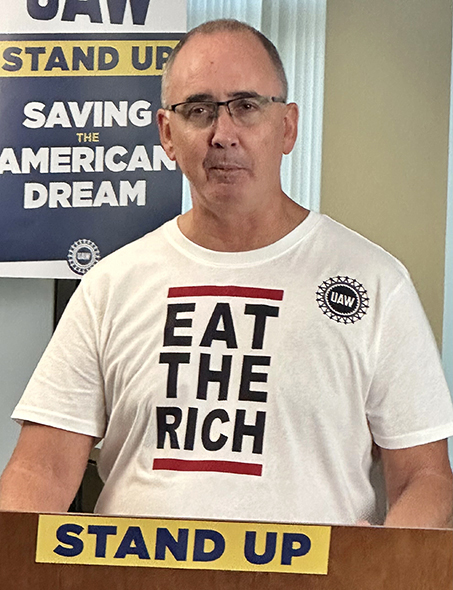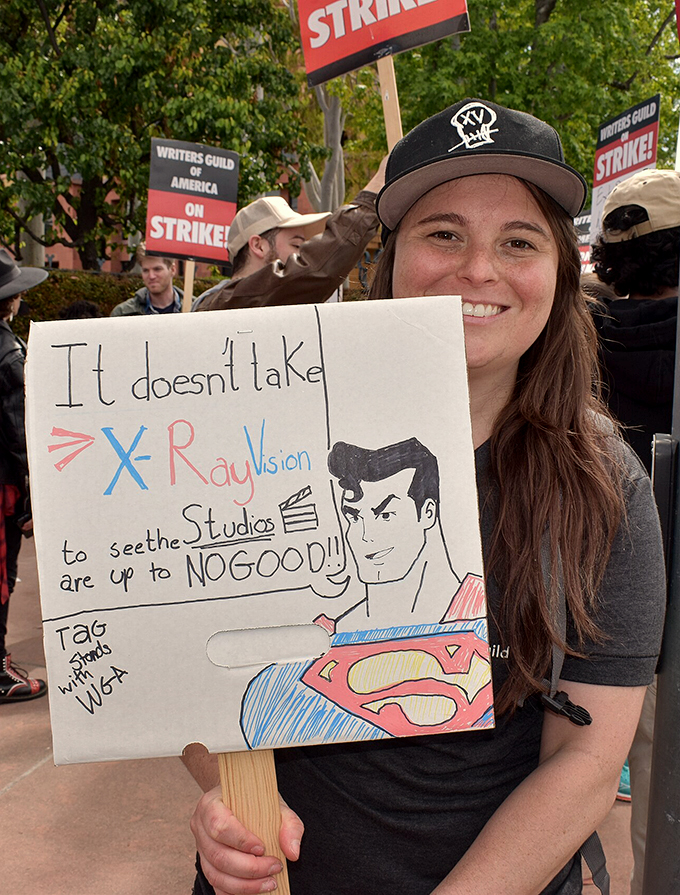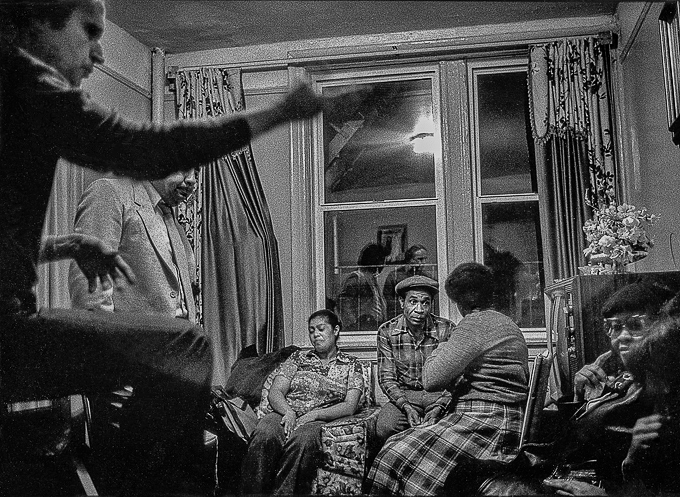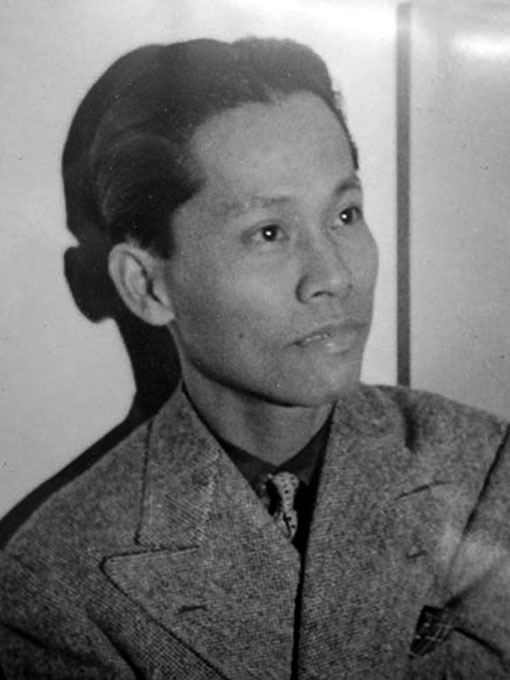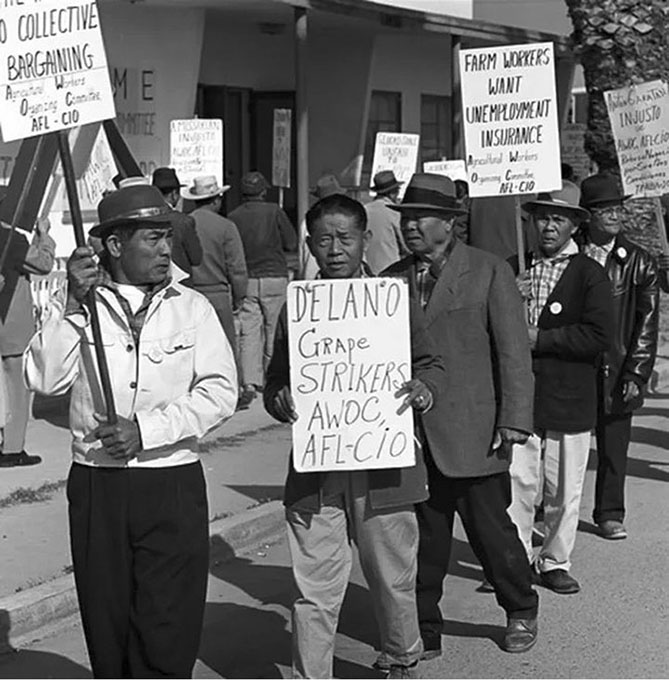“Get Up, Stand Up – Stand up for your right”*
By Peter Olney and Rand Wilson
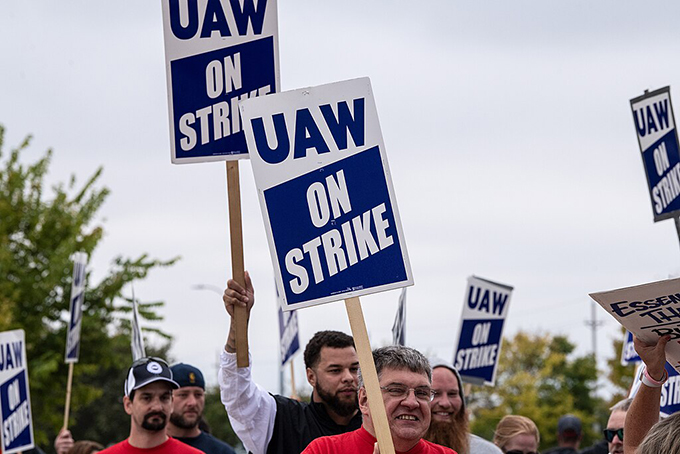
“Stand Up” Strike Gives Autoworkers a Big Win
The “Hot Labor Summer” grew into an even “hotter” labor Autumn for the U.S. working class. The newly reformed United Auto Workers won historic contractual gains by selectively striking the “Big Three” domestic automakers: Ford, General Motors and Stellantis (a merger of Fiat, Chrysler, and Renault). On October 30, the union concluded tentative agreements with all three companies, pending membership ratification votes.
After decades of concessionary bargaining and “labor-management cooperation” that eventually led to financial corruption of top union leaders, the Unite All Workers for Democracy (UAW-D) reform movement won union leadership through the direct election by the members. The one-member, one-vote process for choosing leaders the result of a court settlement on corruption charges against the union and a referendum vote by the membership. UAW leaders were previously chosen at a convention where delegates were often controlled by paid staff from the union’s Detroit headquarters.
The new leadership took charge last March. Upon assuming office, they immediately faced the challenge of bargaining new contracts with the big three auto companies. These negotiations united 150,000 members — mostly employed in Michigan, Ohio, and Indiana.
With significant membership input, the new UAW leadership put forward dramatic demands for the new contracts:
- A 40% wage increase
- Four-day work week, with 40 hours pay
- Restore the Cost of Living Adjustment (COLA)
- Abolition of tiers
- The right to strike over plant closures
- Union jobs in future electric-vehicle (EV) plants where over $100 billion is expected to be invested in EV production creating as many as one million new jobs.
The reform slate’s dynamic new president is Shawn Fain — an electrician from Stellantis’ Kokomo, Indiana factory. During the strike, Fain framed the UAW’s contract battle in class terms, pitting autoworkers against wealthy corporate executives who have seen their compensation grow by 40% since the last agreement.
Fain relentlessly posed the question, what is the worth of workers vs. their employers? After the New York Times mocked his strong class stance, the next day he appeared wearing an iconic T-shirt that said, “Eat the Rich”!
The union called its strategy a “Stand Up Strike” in homage to the iconic 1937 “sit down” strike that birthed the union at General Motors. Back then, autoworkers at the Fisher Body Plant in Flint, Michigan sat down and occupied their plant, cutting off the supply of car bodies and paralyzing the General Motors production process.
On September 15, the union struck all three companies, but only at one of their key assembly plants – GM in Wentzville, Missouri; Ford in Wayne, Michigan; and Stellantis in Toledo, Ohio. Each factory was a “high profit center” for the respective company. These limited strikes allowed the union to conserve its $825 million strike fund which would only have lasted about 90 days if all members at the auto facilities were on strike. While at the same time leaving room for escalation or de-escalation based on the response of the individual companies at the bargaining table -the union conserved resources while keeping management off guard.
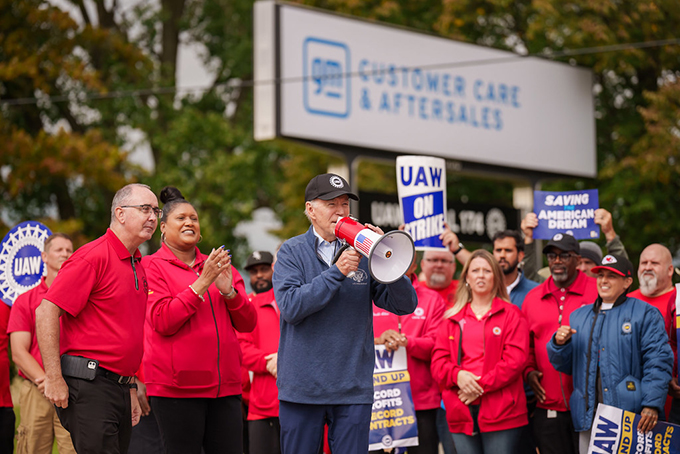
On September 22, the union escalated by striking 38 parts distribution centers in 20 states serving auto dealers for GM and Stellantis. The union’s strategy spared Ford because it had already conceded to demands that electrical vehicles be included under future national contracts and to the right to strike over factory closures. Expanding the strike to the parts warehouses broadened the exposure of the strike geographically, so that solidarity actions and media exposure could take place in far more states while also slowing the flow of parts to auto dealers.
On October 25, the UAW reached a tentative agreement with Ford. Three days later, it reached a tentative agreement with Stellantis, the parent company of the Chrysler, Jeep and Dodge Ram brands. The two deals contain the same or similar terms, including a 25 percent general wage increase for UAW members as well as cost-of-living wage adjustments if inflation flares.
“We have won a record-breaking contract,” the UAW’s Fain, said. “We truly believe we got every penny possible out of this company.”
Shortly after announcing the tentative agreement with Stellantis, the union expanded its strike against General Motors, calling on workers to walk off the job at the company’s plant in Spring Hill, Tenn. The plant makes highly profitable sport utility vehicles for G.M.’s Cadillac and GMC divisions.
The result at General Motors was predictable! The UAW boxed GM into a corner where, if it did not settle, its competitors would gain market share with their employees back on the job. Given that reality, GM settled on October 30 to terms substantially the same as Ford and Stellantis. The settlement includes the elimination of wage tiers at all three companies, so that some workers will see their wages double overnight. All joint venture battery plants will come under the master agreement. In a final brilliant touch, the UAW negotiated a May 1, 2028 expiration date. Announcing the agreement, Fain said, “We invite unions around the country to align your contract expirations with our own,” — a not too subtle call for a 2028 general strike!
With its major sectoral contracts concluded, UAW must now meet an even bigger challenge: Over one million auto workers, largely working for foreign-owned companies, are still not united in a union. Workers at major auto assembly plants owned by BMW, Honda, Hyundai, Kia, Mercedes, Nissan, Toyota, and Volkswagen — and their part suppliers — are working for less pay and far fewer benefits than their union siblings. Most of these companies are located in Southeastern United States where union density and power is below 10 percent. (Read more in the Nation)
The UAW clearly has the not-yet-union companies in their sites: “One of our biggest goals coming out of this historic contract victory is to organize like we’ve never organized before,” Shawn Fain said. “When we return to the bargaining table in 2028, it won’t just be with a Big Three, but with a Big Five or Big Six.”
Already, workers at Tesla’s manufacturing facility in Freemont California are forming a union organizing committee.
The UAW’s “stand up strike” demonstrated the strategic power of organized workers in key nodes of the economy. This revitalized autoworkers movement, along with this historic contract victory, gives us optimism that the difficult, but essential task of organizing more autoworkers is finally within reach.
*By Bob Marley and Peter Tosh
…
The UAW Strike, As of October 9, 2023
By John Womack
The Stansbury Forum is proud to publish a brief analytical piece by John Womack on the ongoing UAW selective strikes against the Big Three domestic auto producers, Ford, GM and Stellantis (Chrysler Fiat)! PM Press recently published a book featuring interviews with Womack, entitled Labor Power and Strategy. John applies some of that analytical acumen in looking at the UAW actions. Since John penned his article on October 9 the UAW has extended the strike to the giant Ford Kentucky Plant that is the company’s most profitable operation. Peter Olney/Co-Editor of the Stansbury Forum and Labor Power and Strategy
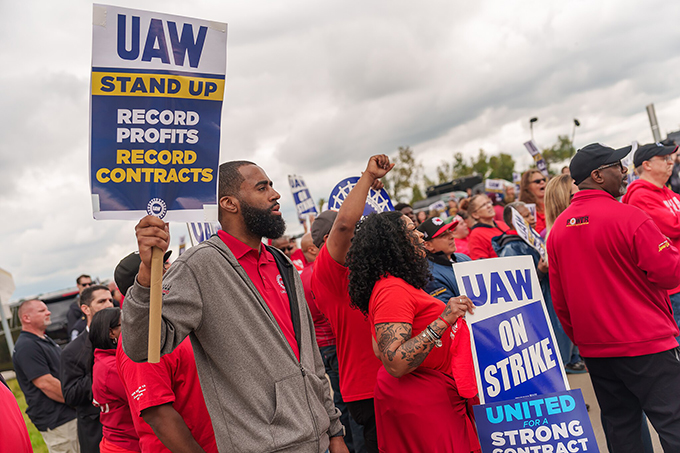
Some 1,700,000 people now work in the automobile industry in the USA. About 150,000 are members of the UAW, mainly in Michigan, Ohio, and Indiana. The union has a strike fund of $825,000,000. If all the UAW workers went out on strike, it would exhaust the strike fund in about 90 days. When the strike began on September 15, Stellantis (Chrysler-Fiat-Peugeot) had 74 days of unsold inventory; Ford had 64 days of unsold inventory, and GM had 50 days.
The UAW had dramatic demands for a new contract: a 40% wage increase (which compounded would amount to 46% over the life of the contract, now reduced to 36%), a four-day work week with 40 hours pay, COLA, the abolition of tiers, union jobs in the electric-vehicle plants the companies are planning, over $100,000,000,000 to be invested in EVs, making 1,000,000 new jobs, about half in the still union-weak South.
The first three plants the UAW struck were GM’s at Wentzville, MO, near St. Louis, Ford’s plant at Wayne, MI, west of Detroit, and the Stellantis plant at Toledo. They were all assembly plants:
- Wentzville made GMC Canyon and GMC Colorado pickups, big money-makers
- Wayne made Bronco SUVs and Ranger pickups, again big money-makers
- Toledo made Jeep Wrangler, SUVs and Jeep Gladiator pickups, again big money-makers.
All told only about 13,000 workers were out, drawing strike pay from the union’s strike fund.
This shows the initial nature of the strike. First, it was a selective strike. It is therefore reminiscent of the Association of Flight Attendant’s intermittent strikes in 1993 against Alaska Airline, when only about a total of 25 workers in various cities over several days walked off one flight after another, causing the airline much trouble and big losses and soon giving the AFA a historic win. The UAW can’t do intermittent strikes. Once it strikes, it has to stay out to the end. But it can do the selective strikes it is doing. For example, if Wentzville, Wayne, and Toledo fail to win the battle, the union could call workers out at other big money-making plants, like GM’s Arlington Assembly Plant, which makes Cadillac Escalades; or Ford’s Kansas City or Dearborn plant, which makes F-150 pickups, or Stellantis’s Stirling Heights or Warren Truck Assembly, which make RAM 1500s.
Second, the choice of this initial strategy is in line with Tom Juravich’s concentration of striking profit centers, striking places where the company makes most of its money. That’s what they study and teach at his UMass Amherst Labor Studies Center, where Olivia Geho staffs a Strategic Corporate Research website.
This selective strategy is different from what Peter Olney, Glenn Perusek, and I argue in our new book, Labor, Power and Strategy. There I focus on what I call technically and industrially strategic positions in the division of labor at work, bottlenecks in the flow of production, choke points. I argue labor should try to hold these positions and use them to disrupt production and bring the boss to see the union’s reason–and power. It is the power workers hold over production and the good they can get from it.
Nowadays, I think I read in The Wall Street Journal, the average internal-combustion automobile has about 30,000 parts, all of which it needs for the average buyer to buy it. Some parts are absolutely essential, like transmissions. GM has five transmission plants of its own, at Bedford and Kokomo, IN, Romulus and Saginaw, MI, and Toledo. Stellantis has three such plants of its own, two in Kokomo and one in Tipton, IN. Ford has only two, one at Livonia, MI, and one at Sharonville, OH. These are technically highly strategic plants. If the UAW strikes them, that in effect closes all the plants that need the transmissions.
It seems to me the UAW at first decided to put their strike fund against Stellantis, Ford, and GM inventories, reasoning that if they did their selective strikes they could run down their strike fund more slowly and outlast the companies. The companies figured they could last longer than the union and did not surrender. But on Friday, September 22, the union expanded the strike to 38 more plants, none at Ford, which had made gone some way to meeting the union’s demands, but at 18 GM plants and 30 Stellantis plants, 38 places closed in 20 states, 8,000 more workers striking (and drawing strike pay). This was a significant expansion, not only because of the numbers, but because these were all distribution centers, basically warehouses that received parts from parts manufacturers and
distributed them to assembly plants. Not many workers were out, but these were all highly strategic plants, choke points in the flow of auto and truck production.
The UAW had indicated it might call out more workers at more plants [and now has extended the strike to the giant Ford Kentucky Plant, the company’s most profitable operation.]
We are now over three weeks into the UAW’s action. Over 25,000 members out of 146,000 are out on strike. The strike fund is still very strong. And the choke points are making the companies’ inventories ever tighter.
The rest of us, pulling for the union, can only wait and see who caves.
…
To Live and Strike in Hollywood
By Gary Phillips
In the seminal book The Hollywood Writers’ Wars by Nancy Lynn Schwartz, completed by her mother Sheila Schwartz upon her daughter’s untimely death, the internal and external battles of Writers Guild of America, WGA, formed in 1933, were chronicled. The Schwartz’s note of this then bourgeois gig:
“It was a great time to be prosperous, young, and progressive in the movie kingdom. You could live better than nine-tenths of the nation yet remain, through political activity, intimately connected to the pulse of humanity.”
That connection would prove to not just be blue-collar lives put to paper and screen by a bunch of lefties and their hardcore red buddies. By the 1940s, writers were seeking to better their working conditions. Not surprisingly as in other labor struggles, they were met with resistance from the bosses. And it wasn’t just writers who found themselves on the front lines.
On October 5, 1945, Bloody Friday, striking set decorators attempting to stop scabs from entering the Warner’s lot were assaulted by police and private security wielding billy clubs, fire houses gushing pressurized water and tear gas. This strike and several other militant ones led to the Taft-Hartley Act of 1947, with Congress overriding a veto by President Harry Truman. Among its provisions, the Act outlawed so-called wildcat strikes.
The latest strike by the WGA was no wildcat action against the Alliance of Motion Picture and Television Producers, the AMPTP. Everyone from the Silicon Valley computer bros turned studio execs, the legacy bosses a la Disney/ABC/Fox and the related personnel like those who supply craft services saw it coming. For the most part the night sticks didn’t come out, though there were several incidents of cars entering the studio lots shaving the distance between it and a picketer. And if a scribe was scabbing, they could do so by zoom and their computer in privacy.
This strike was important in its long-term ramifications too. For the first time since 1960 when both unions walked out, the Screen Actors Guild-American Federation of Radio and Television Artists, SAG-AFTRA, went on strike. This occurred roughly a month and a half after the writers when the actors’ Minimum Basic Agreement, MBA, came due.
For the WGA there were several points of contention. The two main ones were the nature of how residuals were being calculated in the age of streaming, and the onrush of AI as writer. A residual is a percentage of your initial fee as the script writer when the show you wrote or co-wrote is rerun domestically or internationally. This is how it’s still figured for network shows. Heretofore the formula streamers used was a percentage of the earned licensing fee paid to the actors and writers. But only they knew the numbers of subscribers who’d decided to view your program – and therefore didn’t pay out on how many sets of eyes were watching.
During the strike, it was clear those halcyon days written about by the Schwartzes’ were long gone. Several articles penned by established Hollywood writers, those who had sold a show, ran a writers’ room, even wrote movies, still had to have side hustles, and sometimes go on welfare. In my neighborhood there’s the World Harvest Food Bank. It’s a market where for forty dollars patrons can fill up their basket with fresh produce. If you can’t pay, you can still get food as long as you did a volunteer stint. Many a striker still shops there.
Michael Schulman’s piece in The New Yorker, ““Orange Is the New Black” Signaled the Rot Inside the Streaming Economy” is an example of how writers and actors were screwed by the streamers. The article told of the plight of various actors in the Netflix show like Kimiko Glenn and others who were recognized in the streets from their reoccurring roles. But Glenn received foreign residuals totaling less than thirty dollars. Imagine how pitiful the amounts earned by actors in far less hit shows like “Orange” got for streaming residuals. Even the showrunners of the show, not paid starvation wages to begin with, were stunned to find out some 105 million viewers had watched at least one episode of the show. They too did not receive residuals commensurate with those numbers. The MBA now calls for success-based bonuses.
As to AI, there are several; new guardrails in place such as the writer can use AI when performing writing services if the company consents, but the company can’t require the writer to use the likes of ChatGPT. But as many have observed, the digital genie is out of the virtual bottle. For certain there are already scripts and manuscripts being produced by an AI program with the writer giving the work a human rewrite. My short story “The Story Conference” from June on this site doesn’t seem too far off to me. Various outfits such as Meta continue to use AI to scrape, as the term goes, writers’ works — including several of my books, training the AI to replace the flesh and blood writer.
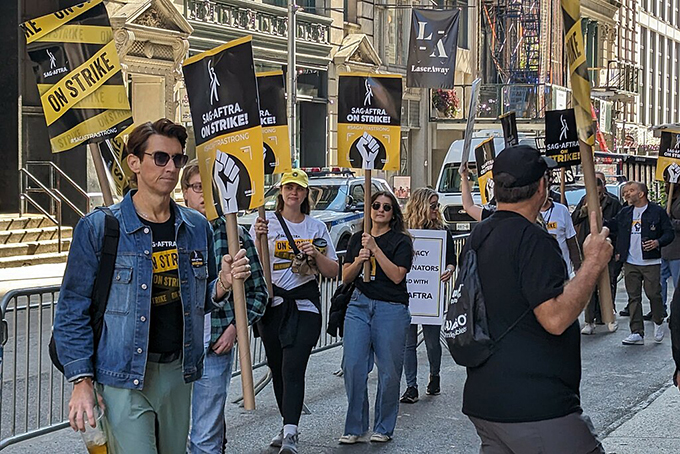
More immediately, the actors remain on strike. It seemed a slam dunk given the WGA’s progress, that as the actors’ talks began with the AMPTP an agreement was within reach. After five days the producers walked away from the bargaining table. They claimed SAG-AFTRA sought a one-dollar levy per year per subscriber to a streaming service. “A bridge too far,” co-CEO of Netflix Ted Sarandos stated. President of SAG-AFTRA Fran Dreschler stated the figure was exaggerated by some sixty percent.
The reality is actors have several distinct issues from the writers they need to have addressed. Be it the notion of self-taping for an audition and the use of AI to capture voice, face, and form. To see more of what SAG-AFTRA is demanding, check out their strike website.
While I’ve admittedly lessened my presence on the strike line in support of my brother and sister actors, I still get out to picket. And when I’m driving there, might be as I’ve seen more than once in the last few days, a driverless car on the roadway. What does it say about the growing presence of AI that these autonomous vehicles are no longer an unusual presence among us?
…
Follow the link for Gary Phillips’ new book:
The Unvarnished Gary Phillips: A Mondo Pulp Collection
End Israeli Apartheid to Give Peace a Chance
By Max Elbaum
Only urgent action that targets roots causes can prevent more deaths, injuries, trauma, and grief. The violence can end only with an immediate ceasefire and rapid steps toward equal rights for all.
When I was a kid, every television station portrayed Native Americans as savages. Those who took their land using “guns, germs, and steel” were depicted as peace-loving bearers of civilization itself.
When I was a youth, I watched footage of General William Westmoreland, commander of the US military forces terrorizing Vietnam, saying with a straight face: “Orientals don’t place the same value on human life that we do.”
In the years since I’ve seen the same kind of dehumanization deployed against people resisting dispossession and structural violence from South Africa to South America and dozens of other places in between.
And always against Palestinians, when their existence was acknowledged at all.
Consolidated Core and Broader Support
Amid the explosion of violence over the last week, a host of voices cut through the racist blather typified by the latest from Israel’s Defense Minister: “We are fighting against human animals.” These clear voices explained what is really going on: the root of violence is oppression. Among them were Arab Resource and Organizing Center (AROC), Jewish Voice for Peace, The U.S. Campaign for Palestinian Rights, left-wing Israeli lawmaker Ofer Cassif, and co-founder of the Progressive International Yanis Varoufakis.
These statements and the numerous demonstrations across the US bringing their message into the streets indicate the gains made by the Palestine solidarity movement over the past several decades. The ranks of those who have cut through all the attempts to obscure the real history of Palestine to target Israeli settler colonialism, the Israeli apartheid system, and the ideology of Zionism that supports it have grown substantially.
Yet pro-Palestine activists have built support beyond this political core. A far broader layer of the population has been won to sympathize with the Palestinians as the oppressed underdog in the Israel-Palestine relationship even if they are not yet fully convinced of anti-Zionist politics. Exposure of the ever-more-blatant racism of successive Israeli governments—the current one is particularly nightmarish—and the settlers (that is, ethnic cleansers) on the West Bank has led to a surge of identification with the Palestinians among US people of color, especially African Americans. Sentiment among young people of all backgrounds has shifted: a slight plurality of millennials (42%) sympathize with Palestinians more than Israelis (40%). Sentiment among Democrats shifted in 2021 – 23 for the first time to favor Palestinians over Israelis, 49% to 38%.
Champions of Palestinian rights like Rashida Tlaib and Cori Bush now sit in Congress. And a broader layer of congresspeople and other elected officials speak out to varying degrees against Israeli brutality and sponsor legislation on that issue in ways that were off the table even just a decade ago.
9/11 Moment: “With us or with the terrorists”
All of these gains have been made on the unfavorable terrain of US politics, where support for Israel has been promoted as a moral and political imperative by the guardians of imperial foreign policy, the powerful Israel lobby, and the fanatical, MAGA-linked Christian Zionist movement. But now the hard-won progress is being rolled back by attacks that will likely intensify in the coming weeks and months.
One establishment pundit after another has embraced the notion of “Israel’s 9/11.” So once again the “with us or with the terrorists” barrage is being deployed against anyone who criticizes US Middle East policy or supports Palestinian rights. Every public figure who does so—from media personalities to college professors, and from celebrities to elected officials—can expect to face charges of anti-Semitism and “siding with terrorism.” Attacks will intensify against frontline activist groups like AROC, the Palestinian Youth Movement, and Students for Justice In Palestine, who have long been targeted with smears, sting operations, and phony legal campaigns.
Elected officials who don’t toe the pro-Israel line are already being targeted. In the last election cycle the American Israel Public Affairs Committee (AIPAC) poured millions of dollars into efforts to defeat not just strong Palestine supporters but even those who seemed inclined to move in that direction. AIPAC recognizes that shifting sentiment around Israel-Palestine in the Democratic Party’s progressive wing poses the threat of support for Israel losing its current status as a “bipartisan” principle, which would be a huge blow to US complicity in Israeli apartheid.
The upwelling of support for Israel in this moment poses serious political challenges for building Palestine solidarity, for defeating an authoritarian right that wants to use support for Israel as one of its battering rams to gain total power, and for contending with Biden’s terrible foreign policy. Republicans are Iran-baiting Biden and the Democrats; centrist Democrats are seizing another means of marginalizing progressives and Leftists; the progressive movement has long split over support for Palestinian rights. The fever of war is fueling religious nationalism at home and abroad.
Palestinians Will Bear the Brunt
Meanwhile the threat of even greater bloodletting looms, with more dead to mourn and wounded to care for on all sides, The Israeli government has already declared war, announced a total siege of Gaza, and is threatening massive military action. Palestinian civilians, who have borne the brunt of violence for more than 75 years, will once more be treated as either explicit targets or irrelevant collateral damage.
So this time for us in the US to stand firm and go broad. Sustain the momentum of street actions and full-spectrum media messaging that targets the underlying cause of the current crisis. Defend every group and individual that gets attacked for criticizing Israel’s brutality—continuing to remind people that outrage against that brutality is not the same as anti-Semitism. Stay in or get in every public space no matter how uncomfortable where a voice speaking against racist dehumanization can find even a toehold. Engage with those progressives who equivocate whether out of simple backwardness or fear of Zionist bullying while building on whatever positive impulses they display.
The immediate days ahead are likely to be very tough. The most strident Israel supporters claim to be moved by the death of civilians, but they reveal their true colors in declaring this a moment of “great opportunity“ to gain more power. But they have no program for the Israel-Palestine conflict except more killing and more subjugation.
The demands for an immediate ceasefire, for an end to US military aid and overall blank-check support for Israel, for equal rights for all to replace apartheid – these light the road to peace with justice. Many who are not ready to support those demands today can be convinced to change their minds tomorrow; just as many who support these views today did not do so five, ten or twenty years ago.
.
This piece was first published by Convergence who have allowed the Stansbury Forum to republish.
…
Crazy
By Eileen Hirst
I awoke to the excited buzzing of text messages from my sister who lives in New England, three hours ahead of my home in San Francisco. Family emergency? No, it was the happiest news a Boston Red Sox fan could imagine at the end of yet another dismal season. Chief Baseball Officer Chaim Bloom had finally been fired, after three losing seasons, this last being a furious race to the bottom of the American League East against the New York Yankees, who had to settle for second worst team in the division.
I ran downstairs, grabbed my Red Sox flag, and hung it from our front balcony. On Opening Day, with all signs pointing to an epically painful season, I’d hung it upside down to signal a Red Sox Nation in distress and now, finally, there was reason to fly it right side up in hopeful celebration. I went across the street to take a picture of it. A man from the landscaping crew that keeps the house two doors up looking like a spread in Fine Gardening approached me. He spoke with a Mexican accent. “Very nice.”
“No kidding!” I said. “Three long years, we’ve had to watch Bloom destroy the team and now, at last, he’s been fired.”
He cocked his head to one side. “Your house, Señora. It looks very nice.”
He was talking about the paint job. I should have left it at that, but in the delirium of myopic joy, it did not occur to me that the entire world had not stopped to honor Bloom’s departure. “The Red Sox. See the logo on the flag? Terrible executive, three losing seasons. He got fired today.”
“Oh, okay.”
I can’t blame him for not sharing my happiness. There are many things not to understand about being a Red Sox fan, starting with why be a fan at all. This is a team whose history includes an 86-year drought in World Series championships, a condition believed to have been brought about by the so-called Curse of the Bambino, punishment to the team for selling Babe Ruth to the Yankees in 1918. This is a team whose star pitcher, Pedro Martinez, during a bench-clearing brawl in 2003 grabbed the head of a 72-year-old Yankees coach and threw him to the ground. On national television. This is the team that has played Neil Diamond’s Sweet Caroline in the bottom of the eighth inning at every home game since 1997 because the best friend of the employee who chose game music that day had just given birth to a baby girl named Caroline. This is the team whose owners were so desperate to fill seats as this train wreck of a season ground to a halt that they designated a game in September as Barbie Night at Kenway – get it? Kenway? – and promised pink t-shirts to those in attendance. Even the team-paid on-air announcers were embarrassed.
It’s hard to explain. It’s like when you voice a deeply held religious belief to a friend and the friend turns to you, incredulous, and says, “You really believe that?”
One dreary February evening some years back, I was working late at my desk in San Francisco City Hall when the Jamaican custodian came in to empty the trash. He asked how my day was going. “Great,” I said, turning my computer screen around so he could see a photo of people standing knee-deep in snow waving at an 18-wheeler big rig. “It’s Truck Day!”
“What’s that?”
“Truck Day. The day the Red Sox equipment truck leaves Fenway Park in Boston to make the trip to spring training in Florida.”
“Oh, okay. It’s a holiday.”
“Well, in Boston it is. The fans stand on the street in front of the ballpark and wave good-bye to the truck.” I pointed to the photo as if that would make it all make sense.
It didn’t. “The players are in the truck?” he said.
“No, just the equipment. Bats and balls. Uniforms. Gloves. Sunflower seeds. That kind of stuff.”
“There’s nobody in the truck?”
“Well, the truck driver.”
His eyes narrowed. “But they wave to the truck?”
“Yes.”
“That’s crazy.” This from a man whose tropical island country has an Olympic bobsled team. You want to talk about crazy? “Why do they do that?”
Why, indeed? Because sports fans do crazy things. You may as well ask why Green Bay Packers fans don hats made to look like giant wedges of cheese. Why Los Angeles Angels fans clutch stuffed toy monkeys at games. What about those squares of terry cloth that teams throughout professional sports distribute for fans to whip over their heads to show support, as if just paying the exorbitant price of a ticket isn’t enough?
And that’s where the real craziness lies, in how much we spend being fans of teams owned by billionaires in sports played by millionaires. Take me, for instance. Admittedly, I could save a lot if I just embraced the Giants, but even after living here for forty-some years, I have never figured out the West Coast style of fandom, which seems to involve supporting your team only when it is doing well and coming home from a game smelling like you rolled in raw garlic.
To fully participate as a Red Sox fan living on the West Coast, here’s how it nets out: I must subscribe to Directv (basic package $183.92 a month) because it is the only provider that offers a regional sports package (another $13.99 a month) that allows me to watch NESN, the Sox’s official broadcast partner. That gets me the pre- and post-game shows, but to see actual games, I also need the MLB package ($149.94 for the season). Then, there’s the digital subscription to the Boston Globe, so I can read the coverage of the disaster I have just watched unfold the night before ($12.00 a month).
Not counting the flag and the flagpole, that’s almost $2700 a year to watch Red Sox owners John Henry (net worth $5.1 billion), Tom Werner ($1.7 billion), and Sam Kennedy (a paltry $315 million) allow Chief Baseball Officer Chaim Bloom to trade away beloved home-grown talent, like Mookie Betts and Xander Bogaerts, while Chris Sale was paid $29 million and change to pitch eleven games in between injuries. $2700 a year to watch manager Alex Cora make the same post-defeat speech game after game. “Yeah, well, we were swinging the bats pretty well, but our pitching wasn’t where it needs to be.”
The day after the 2023 season mercifully ended with the Red Sox in last place for the second year in a row, the ownership announced it would be raising ticket prices, already the highest in Major League Baseball, for the fourth year in a row.
How can that be? Won’t the season ticket holders refuse to renew? Won’t single ticket buyers stay home? Ownership isn’t worried about fan loyalty. Why? Because their jewel of a ballpark is one of the most popular for baseball tourists and fans of opposing teams who want to be able to say they saw a game at Fenway. So what if the people who fill the seats are not Red Sox fans? In the craven collective mind of the ownership, it makes no difference who occupies a seat, be it a lifelong fan who has supported the team through thick and – mostly –thin, or a tourist. A ticket sold is a ticket sold.
Feeling as I do, have I cancelled Directv and gone with a provider whose latest promotion will save me over $100 a month? No. Have I cancelled auto-renew on the MLB package? No. Will I stuff the flag in the darkest corner of my darkest closet or cut it into dust cloths? Of course not. Somewhere around the first week of February 2024, I will need it to announce to my neighbors that it is Truck Day.
Crazy.
…
Where Does Change Come From?
By Mike Miller
Introduction
Change comes from the top. No, change comes from the bottom. Like most either/or disputes, this one offers insights; it can also obscure what is going on “out there” in the world. In the heat of the moment, in the passion of the times, such debates rage. Those who are involved in social movements struggle from the bottom to get people in key decision-making positions at the apex of institutional power to make just decisions on policy matters, or to remove them or create new institutions.
In the mid-1930s, CIO and Mine Workers Union leader John L. Lewis famously boxed President Franklin Roosevelt in by quoting him out of context, and telling millions of industrial workers, “The President wants you to join a union.” FDR was furious, but he couldn’t repudiate Lewis because to do so would appear anti-union. Lewis used FDR’s popularity with workers to build at the bottom.
It is striking that there is often no mention of SNCC and or the Mississippi Freedom Democratic Party (MFDP) in Democratic Party celebrations of its civil rights and voting rights legislation of the mid-1960s.
Almost 60 years ago at the 1964 Democratic Party Convention, the Mississippi civil rights movement forced the Party to adopt civil rights standards for the seating of delegations to the 1968 Convention. But in a bitterly fought contest, the 1964 delegates refused to seat the Mississippi Freedom Democratic Party delegates or offer a 50/50 split delegation to it and the racist “regulars”.
Establishment accounts tell how successful the challenge was. Those who participated had an opposite view. By 1968, MFDP Black delegates were only one quarter of the delegation to the Party Convention, and all the economic justice legislation it supported was left behind.
When we read histories of those struggles, the situational bias of authors becomes apparent because we have the benefit of various reports from differing perspectives. That bias depends on whether the story is told from the point of view of those who sit in the halls of power or those who are the beneficiaries, losers, or objects of their decisions.
From the Student Nonviolent Coordinating Committee “on the ground” view from the trenches in Mississippi, the Kennedy and Johnson Administrations only acted when they were forced to, generally minimally, and only decisively when The Movement created a crisis both within the Democratic Party at home and for the nation’s foreign policy in the cold war (talking democracy to emerging national liberation movements in the third world while African Americans couldn’t vote in the Deep South).
In 1963, I sent a news story I wrote from Greenwood, MS to the Ghanaian Times. It made the paper’s front page and put U.S. representatives there on the defensive. Shortly thereafter, we were called from SNCC’s national office: “Great work. The State Department just complained to us about the Greenwood story.”
It is striking that there is often no mention of SNCC and or the Mississippi Freedom Democratic Party (MFDP) in Democratic Party celebrations of its civil rights and voting rights legislation of the mid-1960s.
Who Should Vote?
It was the decision by “The Movement” to bring illiterate and semi-literate domestics, day laborers, sharecroppers and tenant farmers to the registrar’s office that led to the elimination of “qualifications” from the Voting Rights Act (though no doubt supported by the Justice Department’s civil rights attorney, John Doar, who is one of the heroic figures of the period).
As SNCC’s Bob Moses put it at the time, “You can’t deny Blacks an education then use their lack of it as the reason to exclude them from voting.” Martin Luther King, Jr. and the murdered young women at Birmingham’s 16th Street Baptist Church are properly remembered today.
This option, to this day, remains largely unexplored—one that recognizes both race and class as key factors that an organizing effort must take into account.
And if you want to fully understand how history is made, read the two classic “history from below” studies of The Movement—John Dittmer’s Local People: The Struggle for Civil Rights In Mississippi, and Charles Payne’s I’ve Got the Light of Freedom: The Organizing Tradition and the Mississippi Freedom Struggle, or some of the county and town studies, written by African-American and White writers, or of Unita Blackwell’s story of becoming mayor of Myersville in Issaquena County, or a biography of Fanny Lou Hamer, or of Barbara Ransby’s biography of Ella Baker.
Is Unity Possible Between Blacks and White Working Class People?
There’s an extraordinary story of breaking through White racism at the Laurel, MS Masonite plant in the mid-1960s, and how Masonite used race to divide its workers. In that situation, White former SNCC staffers Jack Minnis and Bob Zellner got Klansmen and Black workers to come together in a united effort. While they failed to defeat Masonite, they demonstrated a possibility for Black-White unity that lasted after the strike’s defeat. This option, to this day, remains largely unexplored—one that recognizes both race and class as key factors that an organizing effort must take into account.
Interestingly, Jones County was a rebel county during the Civil War. As recounted in a current publication of the Jones County Chamber of Commerce (!):
At the beginning of the war, some Jones County men joined the Confederacy, but others refused until the draft was instituted in 1862. One of those was a farmer named Newt Knight. He refused to fight for a cause he did not believe in, although when he was drafted, he did serve as a hospital orderly.
Knight reached his breaking point when he learned that if a man owned 20 or more slaves, he could avoid military service. Knight, and the other poor farmers from Jones County, felt they were right when they suspected the war was a “rich man’s war and a poor man’s fight.” At this point, Knight deserted and went home.
Knight banded together with other deserters and formed a renegade army which was based in the Leaf River Swamp. Their hideout, known as the Devil’s Den, was called home for over 100 Confederate deserters. They came out of the swamp to visit their families, work their farms and according to the stories, conduct raids on trains headed to and from Mobile. The men devised elaborate methods of communication and signals to alert them to impending danger.
History From The Bottom
Most of today’s celebrations of the civil rights movement give us history, “from the top.” Sixty years later, we should appreciate how Justice Department lawyers worked to defend and advance civil rights, and how LBJ twisted arms in the Senate and House to get votes. But 60 years later we should also be able to acknowledge their inadequacies, and the necessity of the demand for change created by The Movement as a lubricant for the engine of change. If we ignore pressure from below, we fail to understand these points:
While it may be true that the Kennedy Administration was interested in early, dramatic, and successful civil rights results, it is also true that the Kennedy Administration was overwhelmingly concerned with getting The Movement off the streets, out of the headlines, and in a position where it was manageable by…the Administration.
To acknowledge the FBI’s role in the film Mississippi Burning while ignoring the fact that the FBI systematically sought to undermine the civil rights movement is a gross distortion of history, that Bureau Director J. Edgar Hoover used his immense power to infiltrate and disrupt civil rights organizations, and that some FBI Agents leaked information to southern racists who tried to use it to destroy civil rights organizations and, in some cases, to murder civil rights leaders, organizers and activists. Hoover was hostile to The Movement, and sought to undermine it with every tool at his disposal.
The Movement successfully challenged the very notion of “qualifications,” when it opposed literacy requirements for voter registration applicants. The Johnson Administration ultimately agreed with this challenge, but not initially and not without fighting it.
The Same Perspective Fits Today
The change from the bottom/from the top question remains today. Nothing better illustrates the synthesis required to get beyond unproductive argument than the Teamster Union internal election of a new president and the union’s victory without a strike at UPS. A key role was played by Teamsters for a Democratic Union (TDU), which supported James Hoffa, Jr’s challenger Sean O’Brien, supported the union’s UPS negotiating package, and held and continues to hold the leadership’s feet to the fire.
Because the word “responsible” has come to have such onerous implications, I hesitate to use it here. But it is the right word.
TDU sees itself responsible for reforming the Teamsters Union and, more broadly, organized labor. That responsibility extends beyond any specific election or contract fight. Each election and contract is understood as an opportunity to both win in the here-and-now and build for the future. What I call “radical patience” is required; that’s the stance of the long-distance runner. We should by now recognize that our fight is a long-haul one, with gains and losses likely along the way.
Keeping our eyes on the prize of social and political transformation requires what Saul Alinsky called “integrated schizophrenia”—a pragmatic, “lesser-of-two evils” understanding of current battles based on the historic experience that deep loses and setbacks don’t move our agenda forward, combined with a critique of the myth of American democracy and a vision of what a real democracy of freedom, equality, justice, community, solidarity, and continuing participation in real decision making by all people would look like.
Keeping our eyes on the stars and our feet on the ground requires yet another dimension of that schizophrenia. We must not only look at single battles or campaigns from the perspective of what is to be won, but also through a lens that asks, “What are we building?”
History Is From The Bottom and The Top
As we both celebrate past victories and watch with frustration and anger as some of them are swept away in a new anti-Reconstruction period, we should remind ourselves of what Black Abolitionist Frederick Douglass said,
“This struggle may be a moral one, or it may be a physical one, and it may be both moral and physical, but it must be a struggle. Power concedes nothing without a demand. It never did and it never will. Find out just what any people will quietly submit to and you have found out the exact measure of injustice and wrong, which will be imposed upon them, and these will continue till they are resisted with either words or blows, or with both. The limits of tyrants are prescribed by the endurance of those whom they oppress. In the light of these ideas, Negroes will be hunted at the North and held and flogged at the South so long as they submit to those devilish outrages and make no resistance, either moral or physical. Men may not get all they pay for in this world, but they must certainly pay for all they get. If we ever get free from the oppressions and wrongs heaped upon us, we must pay for their removal. We must do this by labor, by suffering, by sacrifice, and if needs be, by our lives and the lives of others.”
Frederick Douglass, “If There Is No Struggle, There Is No Progress” (1857
Sixty years ago, when President Lyndon Johnson concluded a speech for the Voting Rights Act with “And we shall overcome,” I was outraged. So were all my SNCC friends.
I think I, and they, were wrong. We won a major victory: our movement’s slogan was now part of official national discourse. But being part of the national discourse is only half the battle. The other is keeping it part of that discourse and extending it so that the words become a continuing reality. Indeed, when we lost at the top—the Mississippi Freedom Democratic Party challenges to the 1964 Democratic Party convention, and to seating Mississippi’s congressional delegation to the House of Representatives at the beginning of 1965—SNCC, already frail, began to unravel. Defeats do not build mass movements or organizations.
As another Abolitionist said,
“Eternal vigilance is the price of liberty; power is ever stealing from the many to the few…The manna of popular liberty must be gathered each day or it is rotten. The living sap of today outgrows the dead rind of yesterday. The hand entrusted with power becomes, either from human depravity or esprit de corps, the necessary enemy of the people. Only by continued oversight can the democrat in office be prevented from hardening into a despot; only by (uninterrupted) agitation can a people be sufficiently awake to principle not to let liberty be smothered in material prosperity.” Speech by Wendell Phillips, January 28, 1852 to the Massachusetts Anti-Slavery Society.
Speech by Wendell Phillips, January 28, 1852 to the Massachusetts Anti-Slavery Society.
…
What is a Labor Organizer?
By Peter Olney
Tools of the Trade
Soon after I retired from the ILWU in 2015 my good friend and comrade Glenn Perusek drafted me to teach organizing and bargaining at the Building Trades Academy (BTA), headquartered, and accredited at Michigan State University.
Glenn told me to meet him in Las Vegas at the local union hall of the Heat and Frost Insulators Union (HFIA) and so began my teaching at the BTA. I confess that in 2015 I did not know what an Insulator was, but soon discovered that it is a crucial part of the construction process: the basic insulation of hot and cold pipes. “Sick buildings” are often the result of poor insulation work that leaves condensate to fester and create harmful mold. The symbol of the craft is the salamander that evidently thrives in heat and cold!
The beauty of teaching and training with the trades is that I knew nothing about construction work, except what my union electrician son teaches me, and I knew less about the organizing process and bargaining in the trades. Those deficiencies forced me to adopt a very participatory form of pedagogy. In other words, my job was mainly a facilitator finding talent and drafting students with expertise who could teach the group. Some students would purposely avoid me at lunch because they knew I was hunting for an unsuspecting instructor for the afternoon session!
As time went on, I taught more Insulators, Cement Masons and Plasterers, Bricklayers and Roofers. I also met some great working-class organizers and made friends with talented co-instructors. Some of the tools that I brought to the jobsite however were universal, and with this issue of the Stansbury Forum we want to start to share them with you, the reader and educator. Every organizing training needs to instill in the students a sense of esprit and pride in their work as organizers just as they have pride in their craft. So, installment #1 of “Tools of the Trade” is a little lesson in Greek, drawing on Aristotle entitled: “WHAT IS AN ORGANZER?”
What is an OPCMIA Labor Organizer?
Each one of you who have decided to become a OPCMIA Cement Masons organizer is entering a select lineup – Labor Organizers. If you go to Wikipedia and look up Union Organizer you will find this description:
“Organizers must be determined, charismatic, and persuasive individuals able to sway groups to action under trying circumstances when jobs are on the line.”
Certainly this description must already make sense to you after the work you have done on job sites with members of the OPCMIA or non-union workers. But you have also discovered that being a good organizer is more than just being a charming and persuasive talker.
You are joining a lineup of esteemed historical figures like Eugene Debs, Mother Jones, Joe Hill, A Philip Randolph and Cesar Chavez. These are Americans who believed in sacrificing their own short-term self-interest and well-being in service of a larger objective of making working people stronger. You are part of organizing and welding individuals into one united fist that can successfully battle the one per cent (1%) in this country.
What a challenge! Did we take any course in high school or college in “Organizing”? Well no, but all of us have had experience in the art and craft of organizing prior to being tapped as an organizer. We have gotten our children up in the morning, fed them breakfast and sent them off to school. We have organized the guest list for our weddings and made sure the wedding party shows up on time. We have put together a recreational softball team and fundraisers for school programs. Maybe we have done safety training for the union or organized our cement or plastering crew.
All of these tasks require thinking beyond ourselves, being accountable, and moving others into action. This is all organizing.
But labor organizing is different in a couple of crucial ways: First, we are talking about people’s jobs, their economic livelihood, the way that they support themselves and their families. Further this organizing does not take place without resistance, either because of fear or antagonisms. In our labor organizing we are challenging others to do something out of the ordinary, something that may involve risking employment, and confronting a powerful employer.
Labor organizing is a mixture of art and science.
“… you don’t dazzle with lectures. You listen and learn from them and acknowledge their knowledge and insights.”
Let’s take it apart and look at the pieces. You are probably familiar with many of these ideas, but it helps to take the pieces of successful organizing, unfold them, and look them over.
Aristotle, the Greek philosopher, wrote an essay on Rhetoric, the science of moving and motivating people to act. What we would call good organizing. Here are three of the important pillars of successful organizing:
Ethos – Street Cred: A good organizer must win the trust and confidence of the audience – his/her co-workers. Being a trained cement mason, or plasterer, gives you a leg up on an outside organizer because you have shared in the work of the workers you are trying to move. They know that when you talk about work you know of what you speak, but you win trust by going beyond shared experiences. You win trust because you keep your promises. You win trust because you follow-up and deliver on answering questions factually. You win trust because you do everything, and more than what you ask others to do. Street Cred is not a static process, it grows as you do your organizing. Sometimes credibility comes from shared experiences. Sports have been a great “cred” builder particularly among male workers. It is often a way to connect with people’s lives when an initial approach is needed to win confidence.
Logos – Reason and Logic: You make logical arguments to the workforce. You present them with facts using verifiable sources and experts. But you don’t dazzle with lectures. You listen and learn from them and acknowledge their knowledge and insights. You take the power of their stories, reframe, and build on them to make your arguments. For instance, one powerful argument against so-called “Right to Work” is the story an organizer tells of watching the cars streaming across the Idaho state border to Washington state in the early AM. Why? Because those workers are coming to work in Washington from “Right to Work” Idaho. Wages are higher in Washington because unions are stronger. An observation that is worth a thousand quotes from experts.
Pathos – Emotion: A good organizer can move the workforce into action; into doing things that make us all stronger. There are many emotions that can kindle action. Fear of change can often be a motivator, when that change is a negative, an attack on living standards. That fear can become anger. Humor can be a relaxer in times of stress that can lead to greater collective will and openness to moving together. A good organizer opens the chest cavity, takes the heart in hand, massages it, and stimulates it into action for the common good. I will never forget attending a funeral for a worker from a warehouse in San Diego, California. Cesario had died because his employer had dropped him from health insurance in violation of the labor contract. Over his grave the workers resolved to avenge his death by fighting for a better contract. They struck the marine terminal the following week and conducted a winning 10-week strike in his memory.
The great Indian freedom fighter Mahatma Gandhi was a skilled organizer, and teacher. Great organizers are great teachers. But you are a teacher not in the way we think of the high school teacher standing and lecturing at a bunch of often-bored students. Our teacher/organizers share the life of the workers they organize. They are accountable and constantly tested by the workers to see if they are keeping their word and following through. Most importantly they are listening and learning from the workforce so that their ideas are refined and perfected in practice.
Organizing is more than anything else a listening art. Ethos, pathos and logos all come from active listening.
You have joined an amazing group of historical figures, some famous many more unknown. It is a lifelong craft and art that constantly requires refining and updating of your skills to meet new situations and methods. Just as civil rights organizers in the South in the 50’s and 60’s took advantage of the telephone to spread their message of resistance and revolt, so today’s organizer uses the modern tools of Facebook, Twitter and Instagram, TikTok. In today’s parlance, organizers are the influencers of the labor movement.
Congratulations. There is perhaps nothing more satisfying that helping your brothers and sisters to be an active part of improving their lives. But while what you do is for others, in acting for and moving others, you enhance your own life and well-being.
Solidarity Forever!
…
FROM SPAIN TO DELANO – THE RADICAL ROOTS OF FARMWORKER UNIONS
By David Bacon
We can’t talk about defending the human and labor rights of farm workers without talking about their history of organizing unions-and the efforts by the government to suppress them. Liberal mythology holds that farm worker unions didn’t exist until the creation of United Farm Workers in the ’60s and that the farm worker unions and advocacy organizations of today appeared out of nowhere, with no history of struggle that went before.
But in fact, during the 1930s Filipinos and other farm workers organized left-wing unions and huge strikes. According to Rick Baldoz, a professor at Oberlin College, “The burgeoning strike activity involving thousands of Filipinos in the mid-1930s occasioned a furious backlash from growers who worked closely with local law enforcement.”
The people who fought to organize unions in the ’30s, ’40s and ’50s on the West Coast were the same people who fought for Spain-in the same organizations, like the International Longshore and Warehouse Union, and especially ILWU Local 37. Of all the efforts to organize farm workers, the ones that were closest to the International Brigades were those of the Filipinos during those years. And the forces that later went after the Lincoln vets were the same as those that went after the farm worker unions, using the same tools: blacklisting and deportations.
Baldoz gained access to the FBI files on one of the most radical of the Filipino leaders, Carlos Bulosan. “The fact that these partisans attracted the attention of federal authorities during the Cold War is hardly surprising,” he says. “Filipino workers had developed a well-earned reputation for labor militancy in the United States dating back to the early 1930s. That a considerable number of Filipinos (both from the U.S. and the Philippines) had volunteered for the International Brigades during the Spanish Civil War… only added to the perception that they were immersed in international left-wing politics.”
In their history of Asian volunteers in the Spanish Civil War, Nancy and Len Tsou write: “At least 11 Filipinos went to Spain to join the International Brigades. Among them, several came from the United States. [Pedro] Penino was able to establish the Rizal Company, a part of the International Brigades named in honor of a Filipino national hero.” The Tsous name the following volunteers: Manuel Lizarraga, Artemio Ortega Luna, Enrique Almenar Gabra, Modesto Ausobasa Esteban, Dimitri Gorostiaga, Eduardo Miranda Gonzales, Pedro Penino, Carlos Lopez Maestu, Mark Fajardo, Servando Acevedo Mondragon and Aquilino Belmonte Capinolio.
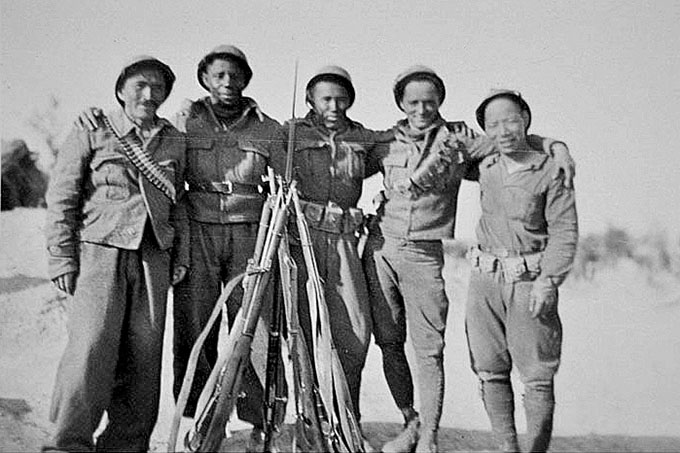
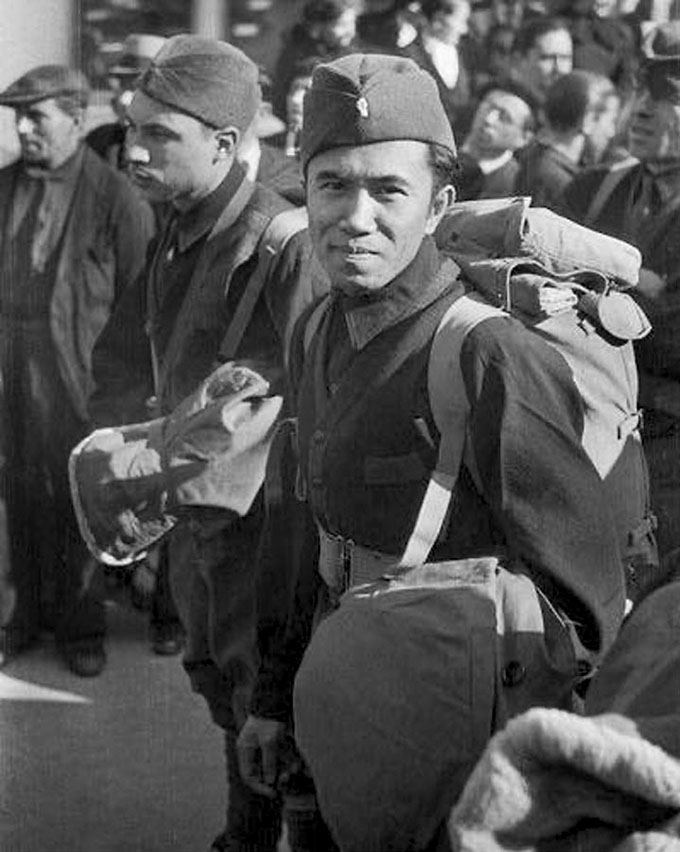
Bulosan had worked as a farm laborer since his arrival in the U.S. in 1930, but after his health was destroyed by his work he tried to make a living as a journalist. “Every word is a weapon for freedom,” the FBI reported him telling a colleague. In 1946, Bulosan wrote America Is in the Heart, a classic and moving account of life as a Filipino migrant farm worker during the 1930s. The FBI viewed the book as evidence of his Communist associations during the Cold War. Bulosan was hired by leaders of Local 37 of the International Longshore and Warehouse Union, Ernesto Mangaoang and Chris Mensalvas, to edit the union’s yearbook in 1952. Among its many appeals for support for radical causes, it urged solidarity with the Huk movement in the Philippines, against continued U.S. imperialist domination of its former colony.
In the 1930s, Local 37 was organized by Filipinos who were the workforce in the salmon canneries on the Alaska coast. They were mostly single men, recruited to come to the U.S. from the Philippines. They were shipped to the canneries from Seattle every season, where they faced discrimination and terrible conditions. They organized Local 37 to change those conditions and forced the fish companies to sign contracts.
Until 1949, Local 37 had been part of the Congress of Industrial Organizations’ (CIO) farm workers union, the United Cannery, Agricultural and Packing House Workers of America. From 1936 to 1953, the U.S. labor movement was split between the left-wing CIO and the rightwing American Federation of Labor. In 1949, as the Cold War started, the CIO expelled nine unions, including UCAPAWA and the ILWU, because of their left-wing politics and often Communist leaders.
At the height of the McCarthyite hysteria more than 30 members of Local 37 were arrested and threatened with deportation to the Philippines. Raymundo Cabanilla, a former CIO organizer, named names to the FBI, identifying fellow labor activists, including Ernesto Mangaoang, as Communists. Eventually Mangaoang’s deportation case was thrown out by the courts. He argued that he couldn’t be deported, given that he was a U.S. “national” when he arrived in Seattle in the 20s. “National” was a status given Filipinos because the Philippines was a U.S. colony at the time. Filipinos couldn’t be considered immigrants, but they weren’t quite citizens either.
Meanwhile, the Federal government tried to bankrupt Local 37 by forcing the accused workers to pay high bails and lawyers’ fees. Union leaders were so tied up in legal defense that a conservative faction took control of the local. That group held it until it was thrown out in the 1980s by a new young generation of radical Filipinos, two of whom, Silme Domingo and Gene Viernes (a former farm worker) were assassinated.
UCAPAWA (renamed the Food, Tobacco and Agricultural Workers) was destroyed in the 1949 purge of the CIO, and the Filipino local in Seattle was taken in by Harry Bridges’ union, becoming ILWU Local 37. It survived, and today is part of the ILWU’s Inland Boatman’s Union.
Today, 52 years after the historic 1965 Delano grape strike, it is important to reexamine this history, especially the radical career of Larry Itliong, who headed the Agricultural Workers Organizing Committee (AWOC). Itliong not only shared leadership with Cesar Chavez but actually started the strike. He had a long history as an organizer.
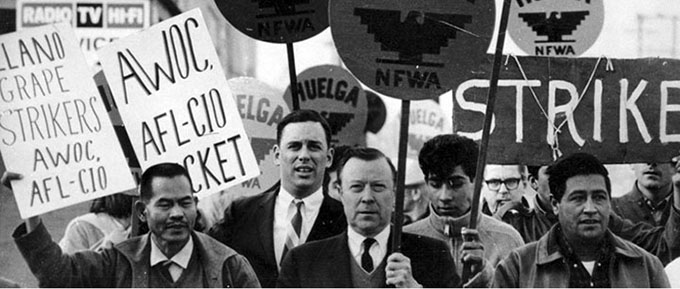
Itliong was Ernesto Mangaoang’s protégé. In the late 1940s, he was Local 37’s dispatcher, sending workers on the boats from Seattle to the Alaska salmon canneries. After the salmon season was over, many Filipinos would return home to California’s Salinas and San Joaquin Valleys, where they worked as farm laborers for the rest of the year. In the segregated barrios of towns like Stockton and Salinas they organized hometown associations and social clubs. Itliong used these networks to organize Filipinos when they went to work in the fields. Along with Chris Mensalvas, at the time Local 37 president, Itliong organized a strike in Stockton’s asparagus fields in 1949.
Once the left-wingers lost power in the union, however, its conservative leaders stopped its farm worker organizing drives. Still, in the early 1950s Filipino farm workers continued to organize. Ernesto Galarza (author of “Merchants of Labor”) started the National Farm Labor Union, which struck the giant DiGiorgio Corporation, then California’s largest grower. In 1959 the Agricultural Workers Organizing Committee (AWOC) was set up by the merged AFL-CIO. After hiring Itliong as an organizer because of his history among Filipino workers, AWOC used flying squads of pickets to mount quick strikes. In 1962, it struck the Imperial Valley lettuce harvest, demanding $1.25 per hour.
The grape strike started in Delano on September 8, 1965, when Filipino pickers walked off the fields. Mexican workers joined them two weeks later. The strike went on for five years, until all California table grape growers were forced to sign contracts in 1970. The strike was a watershed struggle for civil and labor rights, supported by millions of people across the country, breathing new life into the labor movement and opening doors for immigrants and people of color.
California’s politics have changed profoundly in these 52 years, in large part because of that strike. Delano’s mayor today is a Filipino. That would have been unthinkable in 1965, when growers treated the town as a plantation. Children of farm worker families have become members of the state legislature. Last year they spearheaded passage of a law that requires the same overtime pay for farm workers as for all other workers-the first state to pass such a law.
The 1965 Delano grape strike did not, however, start in Delano. It was in the Coachella Valley, near the Mexican border where California’s grape harvest begins, that Filipino workers struck the vineyards that summer. They won a 40¢/hour wage increase from grape growers and forced authorities to drop charges against arrested strikers. The Coachella strike was organized by Larry Itliong. After the grape harvest moved north to Delano, he and the Filipino workers of AWOC walked out again.
The timing of the 1965 strike was not accidental. It took place the year after Galarza, Bert Corona, Cesar Chavez, and other civil rights and labor activists forced Congress to repeal Public Law 78 and end the bracero contract labor program, under which growers brought workers from Mexico under tightly controlled, almost slave-like conditions. Farm worker leaders acted after the law’s repeal, because once the program was ended growers could no longer bring braceros into the U.S. to break strikes.
The Delano strike was a movement of immigrant workers. To organize farm labor, both Filipinos and Mexicans wanted to keep growers and the government from using immigration policy against them. In ending the bracero program, they sought instead immigration policies favoring families and communities. In the 1965 immigration reform they established family reunification as a basic principle of immigration policy. This enabled thousands of people, especially family members of farm workers, to come from the Philippines, Mexico and other developing countries.
The Delano strike was not spontaneous or unexpected. It was a product of decades of worker organizing and earlier farm worker strikes. Many Filipino workers in Coachella and Delano were members of ILWU Local 37 in 1965, when the grape strike began. Every year they still traveled from the San Joaquin Valley (where Delano is located) to the Alaska fish canneries. Through the end of their lives, they were often active members of both Local 37 and the United Farm Workers.
Cold war fears of communism were strong in the 1960s-one reason why the contributions of Itliong and the Filipinos were obscured. The strike in Delano owes much to Cesar Chavez, Dolores Huerta, Gilbert Padilla, and other Chicano and Mexican leaders who came out of earlier community organizing movements. But the left-wing leadership of Itliong, Philip Veracruz and other rank-and-file Filipino workers was equally important.
Chavez willingly acknowledged that the NFWA hadn’t intended to strike in 1965. The decision to act was made by left-wing Filipinos, a product of their history of militant fights against growers. Their political philosophy saw the strike as the fundamental weapon to win better conditions. And it was a decision made by workers on the ground, not by leaders or strategists far away.
Growers had pitted Mexicans and Filipinos against each other for decades. The alliance between Itliong’s AWOC and the Cesar Chavez-led National Farm Workers Association (NFWA) was a popular front alliance of workers who had, in many cases, different politics. AWOC’s members had their roots in the red UCAPAWA. NFWA’s roots were in the Community Service Organization (CSO), which was sometimes hostile to Communists. Yet both organizations were able to find common ground and support each other during the strike, eventually forming the UFW.

Strikers in Delano developed close friendships. Cesar Chavez’s son Paul recalls the way the older Filipino men looked at him and other children of Mexican strikers as their own family. Most of the Filipinos were single men, because anti-miscegenation laws prohibited them from marrying non-Filipinas, and the immigration of women from the Philippines was limited until the late 1960s. In the wake of the grape strike, the UFW and scores of young activists from California cities built a retirement home for them in Delano, Paolo Agbayani Retirement Village, to honor their contribution.
Philip Vera Cruz, a Filipino grape picker who became a vice-president of the UFW and later left over disagreements with Chavez, wrote during the strike’s fourth year: “The Filipino decision of the great Delano Grape Strike delivered the initial spark to explode the most brilliant incendiary bomb for social and political changes in U.S. rural life.”
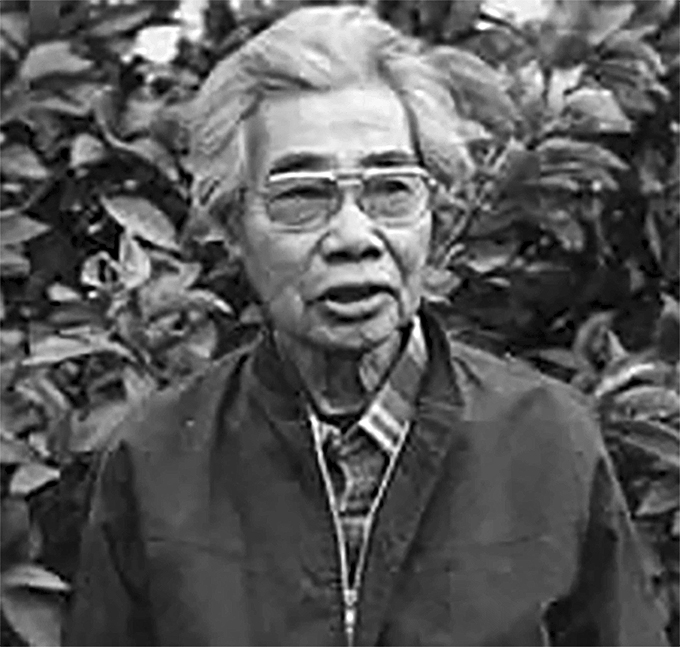
Liberal mythology has hidden the true history of the grape strike’s connection to some of the most radical movements in the country’s labor history. The contribution of that generation of Filipino radicals, including some who went to Spain, should be honored- not just because they helped make history, but because their political and trade union ideas are as relevant to workers today as they were in 1965. Those ideas, which they kept alive through the worst years of the Cold War, led to a renaissance of farm worker organizing that is still going on.
…
This article was first published in “The Volunteer,” February 27, 2018: https://albavolunteer.org/2018/02/human-rights-column-from-spain-to-delano-the-radical-roots-of-farm-workers-unions/
“A World in Common” – A Review of the TATE photography exhibit
By Stuart Freedman
As those of us who have spent a lifetime trying to use photography as an (albeit imperfect) instrument of change, the reflection that the medium itself was originally central to the European conquest of others is an irony that cannot be ignored. Or unseen.
It is these historical representations that Tate Modern’s show, A World in Common, seeks to confront and engage with. This is the gallery’s first major exhibition that explores contemporary photographic practice from that continent reimagining what Africa is, was – or might be – as seen through the eyes of some of its own artists.
Comprehensive in scope and featuring a mixture of photography, video and installation, it exposes work from thirty-six artists delineating narratives from an enormous, almost unimaginable territory that is at turns recognisable, unfamiliar, thrilling and baffling in equal measure. It is a noble aim but ultimately its breadth is also its weakness.
The show opens with George Osodi’s stately portraits of Nigerian Queens, Kings and Gods, that uncomfortably (and presumably unintentionally) echo the class basis of imperial monarchical rule in a visual language that is redolent of Victorian portraiture.
Indeed, by and large the show leaves open the question of who has the power to record the lives of others and here it is largely the gaze of Africa’s new urban middle classes that replaces a Western one. That said, the interiority of that gaze undeniably expresses what Jennifer Bajorek has referred to as “the urgency of African and Black futures.”
It is to those complex and myriad futures – and to the aesthetic of Afrofuturism (first coined way back in 1993 by Mark Dery) – that the show tries to point. Which is all the more confusing when the (white) Spanish photographer Christina de Middel’s imaginative fiction, Afronauts (about the Zambian space project) is included on the walls. Kiluanji Kia Henda’s ephemeral installations in the Namibian desert to
comment on Luanda’s construction boom is questioning but it is Kiripi Katembo’s Un Regard (2008-13) using dreamlike puddle reflections of Kinshasa that is a real showstealer. These imagined sets contrast with the of ‘counter-histories’ of Lazhar Mansouri’s Portraits of Aïn Beïda (c.1950s-70s) and Santu Mofokeng’s The Black Photo Album / Look at Me (1997) asks different (and sometimes tricky) questions about historic self-representation.
It is the show’s engagement with Africa’s spiritual world however that is the most dense and beautifully ambiguous. The spiritual remembrances especially in Khadija Saye’s in this space we breathe (2017), explore and re-enact the profound rituals in her own mixed faith background. This (literally) haunting work from Saye, a young
Gambian-British artist who perished in the Grenfell fire at only 24, reminds us what a talent that shone brightly and was lost. Em’kal Eyongakpa’s Ketoya speaks #1, (cluster II), 2016 – photographs of Cameroon’s sacred lands (a site of significant resistance to German colonialism) is a darkly haunting document of struggle and memory. Maïmouna Guerresi’s Sufi inspired work, M-eating – Students and Teacher, 2012 couldn’t be more different – full of colour and geometry but equally engaging.
The last piece, JulianKNXX’s In Praise of Still Boys, 2021 is an extraordinary finale that combines poetry, film and music that unites the artist’s memories of growing up in Sierra Leone, war and slavery. Narrated by his mother in her native Krio, it fittingly imagines a stepping-off point, both physical and psychic from a past that is open and yet to be imagined.
A World in Common is on show at London’s Tate Modern until January 14th 2024.
…
We Shall Overcome
By Mike Miller
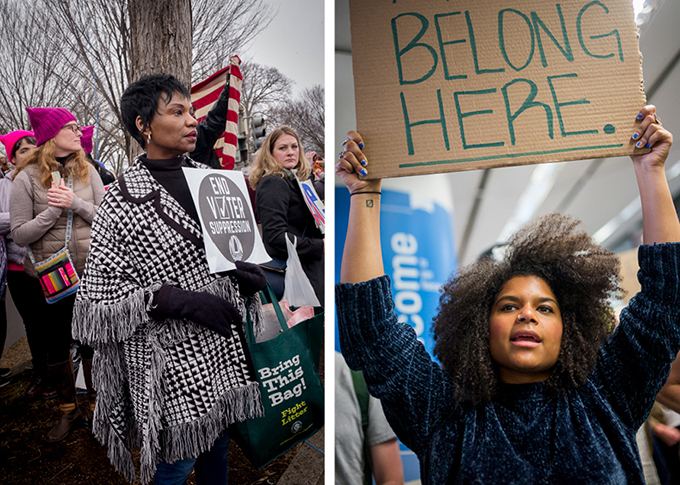
I haven’t read anything in a long time as important as Crispin Sartwell’s “Can Jelly Roll Heal the Broken Soul of America”. Here are excerpts:
“Jelly Roll is a recovering addict whose life has been riddled by drug-related loss…
From: “Can Jelly Roll Heal the Broken Soul of America? New York Times. July 23, 2023.
He openly swears, drinks, smokes weed and has a history of criminal convictions and substance-abuse problems.
He hasn’t become a star in spite of those things, but because of them. And that popularity is as revealing about the condition of the American soul as it is about the artist himself…
[He sings] with a gospel-and-rap-inflected brand of country that plumbs the depths of addiction, regret, grief and helplessness…
[T]he show [is] “a 12-step meeting, a revival, and a party all at once.”…
In a country riddled with crises — the opioid epidemic, mass incarceration, the mental health crisis and gun violence among them — Jelly Roll’s music is an expression not just of musical tastes, but also of a desperate national hunger for healing and recovery…
Even as I struggle from day to day, it’s good to know I’m not the only one still desperate for reconciliation and connection.”
To those lines, he could have added the other cultural, economic, political and social issues of our day.
From childhood memories, I think the late 1930s American Communist Party through World War II–marred deeply by support of the Hitler-Stalin Pact and sectarianism in relation to the rest of “the left”– may have captured what Sartwell and Jelly Roll are talking about: a crisis of the spirit.
During my lifetime, the early student movement at UC Berkeley, in the campus political party “SLATE” (I was first chairman), the United Farm Workers of America (I was co-director of its Schenley Liquor Boycott) and the Student Nonviolent Coordinating Committee—“Snick” (I was a full-time “field secretary” from early 1963-end of 1966), each expressed a spirit that touched the soul.
In several-day marathon-long staff meetings, more than a hundred Snick field secretaries engaged in intense debates that threatened to divide the organization. In the wee-small-hours of the morning, when reconciliation seemed impossible, one of us who was Black would rise and start singing “We Shall Overcome.” We would all get in a circle, cross our arms, hold the hand of the persons on each side of us and, slightly rocking side-to-side, and join in the singing. We realized there was something bigger in what we were doing than any single issue that faced us. Until the mid-1960s, that spirit governed Snick’s operation.
I see hopes for a renewal of that spirit in much of the new labor organizing bubbling up from the bottom at Amazon, Starbucks, Trader Joe’s, and other workplaces, and the Teamster Union preparation with its membership for UPS negotiations.
I see it in some of the community organizing now taking place in the country.
I see it in some of the electoral campaigns waged by “progressives” and other reformers.
I see it in the campaigns against climate pollution, racism, sexism and others.
The crisis of the spirit prompted by endless greed and vast inequality of wealth, status and power, war, looming environmental disaster, and hostility to and discrimination against “The Other” shall be overcome–
Or we will die as a nation.
…
